
| Build-Your-Own | Main Panel
| Dipole Woofer | Dipole
Woofer 2 | Dipole Woofer 3 | Crossover/EQ
| Supplies |
| System Test | Design Models
| Prototypes | Active Filters
| Surround | FAQ |
Alternate drivers for the PHOENIX dipole
woofer - 3
As I indicated in FAQ4 I have
been trying to find a large excursion 12" driver that would give me twice
the useable volume displacement as the 1252DVC or X6100 for 6 dB more acoustic
output at about the same level of non-linear distortion. The cabinet size should
increase only marginally and the cost of the driver should not more than
double. This would allow me to obtain the same output with two such drivers
in the PHOENIX woofer cabinet as I now get from four X6100 in a cabinet of twice
its height.
Indeed, I found a driver that meets my requirements. It is
the Peerless XLS series
model 830500, a 12" (Sd = 466 cm2)
unit with Xmax = 12.5 mm peak excursion. While other units on the market claim
similar excursion capability, they usually suffer from excessive air turbulence
and other noise at large displacements, which effectively reduces their useable
excursion to 6 mm for open baffle applications.
The performance of the 830500 comes at the cost of lower
sensitivity and early roll-off, as shown in comparison to the frequency response
of the 1252DVC. All the following data are taken at about 2" from the
dustcap of the unbaffled driver.
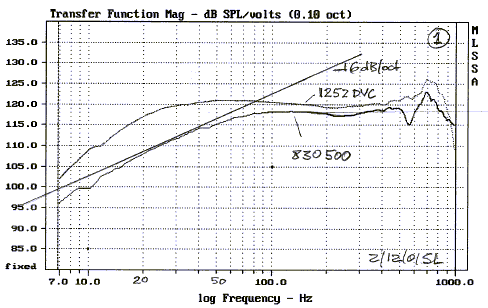
An analysis of the
driver terminal impedance curve explains the roll-off behavior. The low Qts <
0.5 leads to real axis poles at 86 Hz and 4 Hz in the second order highpass
polynomial and thus to the shallow 6 dB/oct roll-off.
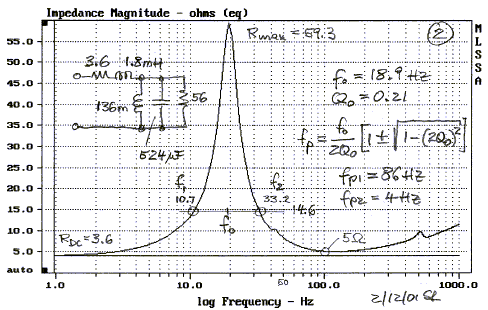
Some example harmonic distortion measurements show the
superior performance of the 830500. Second order distortion will be further
reduced due to the driver arrangement in the PHOENIX woofer cabinet.
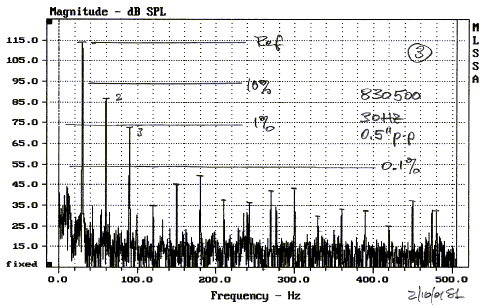
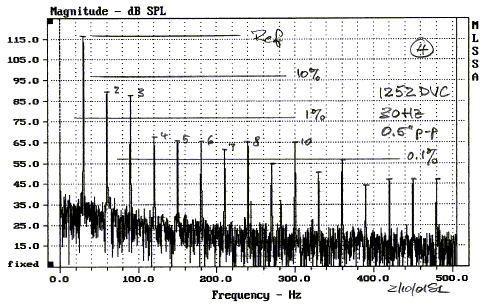
What the graphs do not convey properly is the audible
improvement of the test tone cleanliness. This is especially remarkable for a 20
Hz tone at 1" p-p excursion.
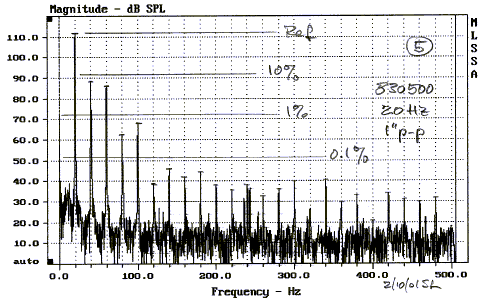
The amplifier requirements for excursions up to 1"
p-p below 40 Hz are not too severe, because of the high, and somewhat capacitive
driver impedance, (2) above. At 20 Hz a 25.4 Vrms signal across the
60 ohm driver impedance will produce 1" p-p excursion. That corresponds to
11 VA in power.
At higher frequencies, though, it takes considerable power to achieve 0.5"
p-p and at 100 Hz even a 200 W/8 ohm amplifier will have difficulty to give more
than 0.25" p-p.
You can derive this from the graph below which gives the rms voltage necessary
for 0.5" p-p excursion and the power in VA that the amplifier must deliver
to the load (2).
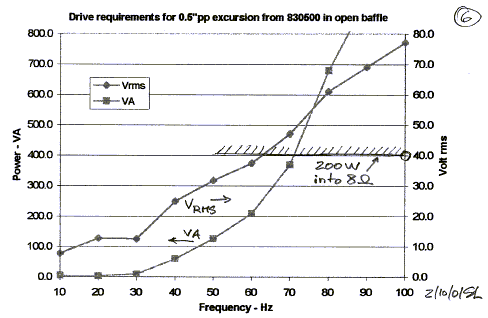
The 1252DVC, in comparison, requires less power, but it is
also limited in excursion before the driver misbehaves. For example, 0.5"
p-p excursion is only obtainable below 40 Hz, because around 50 Hz the voice
coil walks forward out of the gap at large signal levels. The useable
displacement thus tends to 0.25" p-p for higher frequencies. Even so,
around 80 Hz the cone has two conditionally stable rest positions and it is
difficult to preserve a 0.25" p-p excursion. No such behavior was observed
with the 830500.
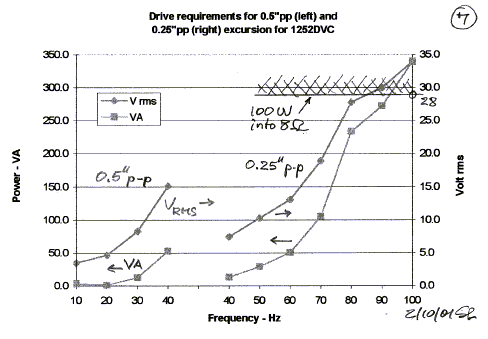
In practice the amplifier power requirements are not quite
as severe as it may seem from the graphs above. For an open baffle woofer the excursion
falls off at (1/f)3 with increasing frequency for constant SPL. The
real problems are distortion and insufficient output at the low frequency end.
Based on the measured data for cone excursion versus drive
voltage and frequency, I made an estimate of the sound
output at 1 m into half-space, if two of the 830500 are wired in parallel.
The two drivers in parallel generate 6 dB more SPL than a single unit, but the
amplifier has to drive an impedance that drops as low as 2.5 ohm at 100 Hz. I
assumed an amplifier with 100 W into 8 ohm specification and sufficient current
capability to deliver up to 200 VA into the varying speaker impedance. The
analysis shows that such amplifier can drive the two 830500 to 1" p-p
excursion only below 40 Hz before running out of power. Above 40 Hz the cone
displacement is limited by the 200 VA of the amplifier.
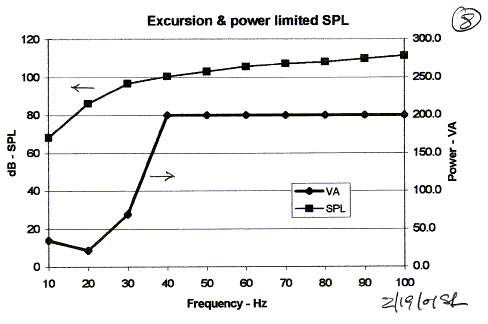
With the two drivers in an open baffle of front-to-back
spacing D=19" (483 mm) the resulting SPL increases from 68 dB and 25 mm p-p
excursion at 10 Hz to
111 dB and 3.6 mm p-p at 100 Hz. A second woofer adds another 6 dB. These are quite respectable
numbers.
Connecting the two drivers in series gives lower maximum
SPL, because the cone excursion is limited at all frequencies by the 28.3 Vrms
output voltage of the 100 W amplifier. SPL increases from 67 dB and 23 mm p-p
excursion at 10 Hz to 107 dB and 2.3 mm p-p at 100 Hz. The minimum amplifier
load impedance is now 10 ohm and might be more advantageous, if the amplifier
has less output current capability.
Neither series nor parallel connection of the two drivers
changes the low Qts. The corresponding early roll-off has to be equalized in
addition to the normal 6 dB/oct open-baffle roll-off. The low Qts is an
indication of the high motor strength and keeps drive requirements reasonable.
There are other alternatives available besides the 830500,
which provide lower distortion than the 1252DVC/X6100, except that their useable
maximum SPL is not significantly improved. See Woofer2.
Use of 830500 drivers for the PHOENIX
woofer
The PHOENIX printed circuit board lacks the necessary
circuitry to equalize the ~86 Hz roll-off due to the low Qts of the driver. A
single MT1 circuit board can provide this
equalization for two woofers. Details are included with the WM1/MT1
documentation. In addition, the MT1 pcb could also be used for a 100 Hz, 24
dB/oct woofer to midrange crossover, should that become desirable.
Alternatively, the WM1
circuit board provides this capability and also allows correction of the 6
dB/oct dipole roll-off. Thus, using the WM1, two fully equalized dipole woofers
can be built. They are easily crossed over and mated with any midrange units by
using an additional MT1 printed circuit board.
Component values for equalizing a PHOENIX style woofer (see below) are included with the
WM1/MT1 documentation. Also provided is specific
information for equalizing an H-frame
woofer cabinet for crossover frequencies up to 150 Hz. This is of interest when
the H-frame acts as the base for another speaker that cannot be crossed over lower than 150 Hz.
Dipole woofer cabinets for the
830500
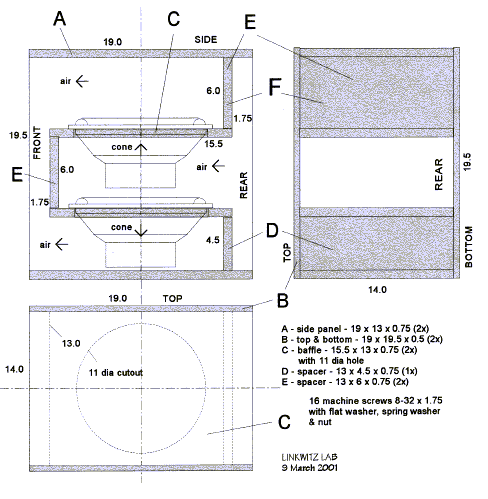
The width of the cabinet could be reduced from 19.5"
to 18" by changing the width of spacer F from 6" to 4.5". This
will require installing the top driver while one side panel is removed and makes
assembly more difficult.
Great care must be taken during assembly that no particles fall into the exposed
magnet gap behind the spider. The drivers are arranged for even order distortion
reduction.
For a loudspeaker of the Beethoven-Grand or -Elite output
level capability I recommend to use four drivers per side. If used with the
PHOENIX, then the 100 Hz crossover should be 4th order
for compatibility with the 21W/8554 and the increased excursions that might be
demanded from it during very high playback volume levels. When four drivers are
used, the two drivers in each of the stacked cabinets can be mounted for a
cleaner front-to-rear acoustic path. In that case even order distortion
reduction is obtained by reversing one of the cabinets as shown below.
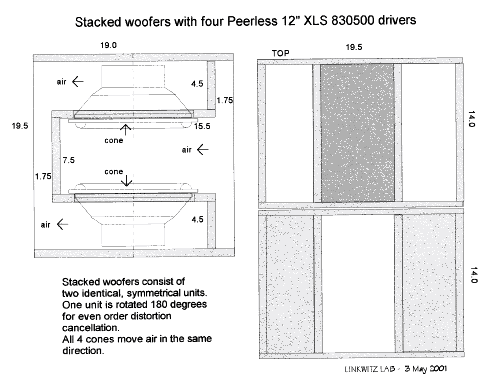

| Dipole Woofer | FAQ
|
|